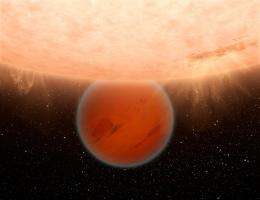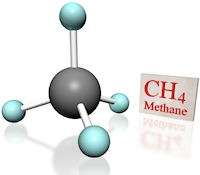Lack of methane to blame for planet's 'smell'

Giant planet GJ 436b in the constellation Leo is missing something. Would you believe swamp gas?
To the surprise of astronomers who have been studying the Neptune-sized planet using NASA's Spitzer Space Telescope, GJ 436b has very little methane (CH4).
"Methane should be abundant on a planet of this temperature and size, but we found 7000 times less methane than what the models predict," says Kevin Stevenson of the University of Central Florida (UCF). Stevenson was lead author of a paper reporting the result in the April 22, 2010, issue of Nature.
The methane deficit is surprising because in our own solar system all gas giants are methane-rich. Hydrogen and carbon are abundant in the atmospheres of Jupiter, Saturn, Uranus and Neptune. These atoms naturally get together to form the simplest hydrocarbon, CH4.
The example of our local gas giants shaped expectations when Stevenson and colleagues pointed Spitzer in the direction of GJ 436b, only 33 light-years away. Finding methane was a foregone conclusion. But when the researchers analyzed the planet's spectrum, they found little of it. Instead, the atmosphere was rich in carbon monoxide.
"Actually, it blew our minds," says principal investigator and co-author Joseph Harrington, also of UCF.
Where did all the methane go? One possibility: it's being broken apart. "UV radiation from the planet's star could be converting the methane into polymers like ethylene," says Harrington. "If you put plastic wrap out in the sun, the UV radiation breaks down the carbon bonds in the plastic, causing it to deteriorate as the long carbon chains break. We propose a similar process on GJ 436b, but there hydrogen atoms split off from methane and let the remnants stick together to make ethylene (C2H4)."

Also, they speculate, strong vertical winds in the planet's atmosphere might be sweeping up material from deep hot layers where carbon monoxide is abundant. CO thus replaces CH4.
Or it could be something else entirely.
"This planet's atmosphere could have some sort of alien chemistry going on," says Harrington. "We just don't know yet."
Giant planets aren't the only worlds with methane. CH4 is fairly common on Earth, too. Methane forms in the stomachs of cows and goats. It also bubbles up from the bottom of swamps, a byproduct of organic matter decaying in deep mud. On gas giants, methane is just common chemistry, but on our planet, it is a sign of life.
For this reason, researchers have long planned to look for methane in the atmospheres of distant Earth-sized planets. NASA's Kepler mission is expected to discover many such worlds. Methane floating alongside oxygen could be compelling evidence of biological activity.
But what if planetary atmospheres don't always follow the rules of our own Solar System? GJ 436b certainty doesn't. Investigators might have to go back to the drawing board and re-figure their chemistry.
"GJ 436b is telling us something important," says Harrington: "We’re not in Kansas anymore."
Provided by Science@NASA
















